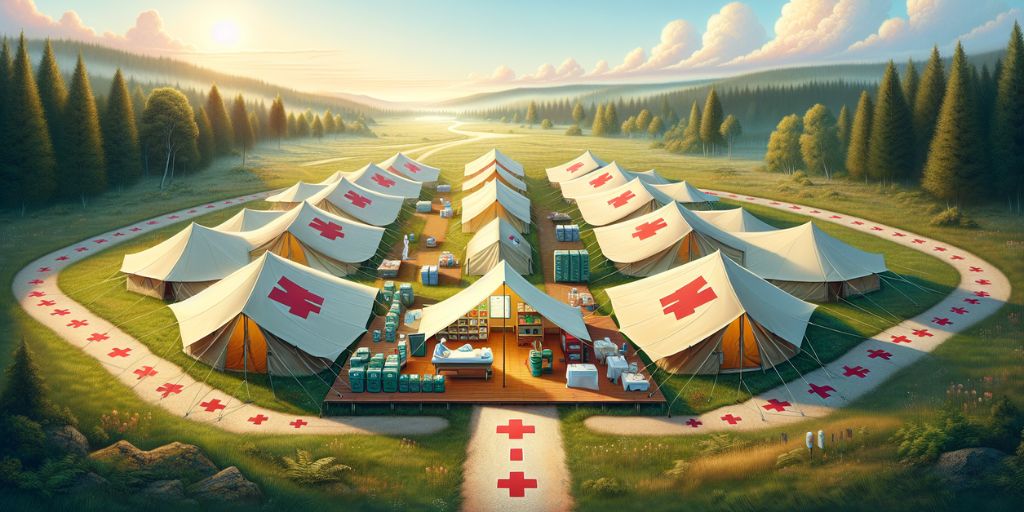
In times of widespread medical emergencies, such as natural disasters or pandemics, the healthcare system often faces the herculean task of responding swiftly. As we’ve seen in recent years, the concept of field hospitals has morphed from a wartime relic to a modern-day necessity.
Temporary medical facilities become beacons of hope and recovery, providing essential care at times when traditional hospitals are either out of reach or overwhelmed. Sitting within tents or repurposed buildings, they represent a crucial juncture between immediate disaster response and sustained community resilience.
Understanding the Vital Role of Temporary Medical Facilities
Field hospitals harness flexibility and agility in healthcare delivery. When crisis strikes, they are assembled almost overnight, bringing medical services directly to those most in need. The recent global health challenges have underscored their importance, showing how a rapid and scalable approach to care is invaluable. For example, after a catastrophic earthquake, these units can offer immediate relief, performing life-saving surgeries mere meters from the disaster zone or providing ongoing care as communities rebuild.
Adapting to the Needs of Disaster-struck and Remote Areas
The adaptability of field hospitals also extends to remote locations, serving populations cut off from regular healthcare access. They bridge service gaps, ensuring rural dwellers receive the same critical interventions as urban residents. Take, for instance, a mobile clinic navigating through a remote village to provide vaccinations and basic healthcare screenings. It’s not just about putting up a tent; it’s about delivering hope on wheels to those who otherwise might be left behind in the healthcare landscape.
Embracing Health Knowledge as a Vital Tool
While field hospitals address immediate physical health needs, the empowerment of individuals through health knowledge should not be underestimated. Being well-informed about health matters can help people to make more informed decisions about their care.
With an abundance of health-related resources available online, it’s possible for people to learn about various conditions, treatments and prevention strategies, putting a wealth of knowledge at their fingertips and fostering a partnership between patients and healthcare providers.
The Transformative Trends of Telehealth and Preventive Care
Technology is not just about information; it’s also about access. Telehealth emerges as a formidable ally in modern healthcare, with virtual consultations ensuring continuity of care. Similarly, digital solutions support preventive care initiatives, providing tools that remind, educate, and engage patients in maintaining their health. The convenience of a video call with a doctor or a smartphone notification to take medication is reshaping healthcare experiences, making them more accessible and personalized than ever.
How Virtual Consultations are Supplementing Traditional Visits
Consider the comfort and ease that come with seeing a healthcare professional through a screen, at a time and place that suits the patient. Whether it’s a follow-up appointment, a mental health session, or a discussion about a new prescription, telehealth provides the flexibility to fit medical care into busy lives smoothly. This technological embrace allows healthcare to evolve, meeting the needs of modern society where instant, reliable connectivity is a daily norm.
Emphasizing the Prevention of Illness through Technology-aided Initiatives
Educational apps and online tracking tools encourage self-care and disease prevention. For instance, someone with a family history of heart disease can use an app to track their exercise routine, diet, and medication, playing an active role in managing their health risks. This preventive approach is more critical than ever, as healthcare systems globally strive to shift focus from treating illness to maintaining health, ultimately aiming to reduce the burden on medical facilities, whether they are field hospitals or permanent institutions.
Summing Up
As we navigate through an era where health information and technology blend seamlessly into our lives, the lines between traditional and digital healthcare continue to blur. The era of standing alone in our health journey is behind us, replaced by one of informed, communal, and technologically-empowered wellness.
Whether we are discussing the swift rise of field hospitals in remote regions or the latest app that tracks our sleep patterns, the goal remains steadfast: to promote comprehensive well-being for every individual, regardless of where they stand on the globe.


